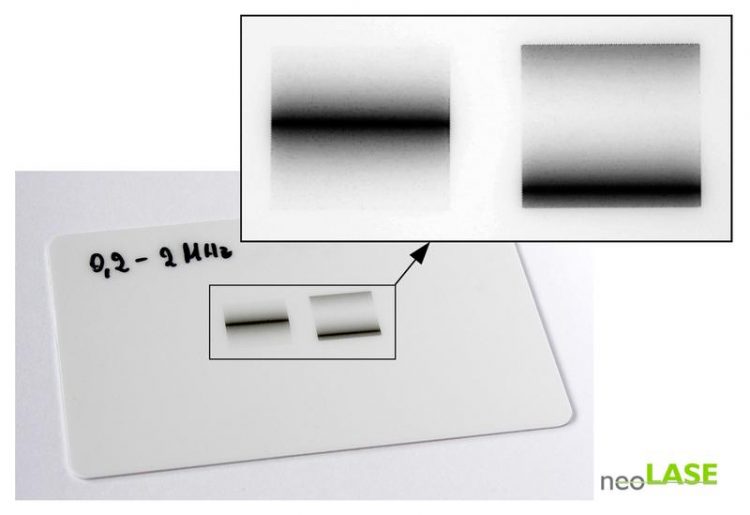FlexPulse: Picosecond pulses with arbitrary pulse sequence and energy

Fig. 1: Gray scale picture produced with constant scan speed
The increasing demands in laser material applications require high flexible and comprehensive laser systems.
For these areas neoLASE developed a new picosecond laser system with a unique flexibility in terms of pulse control.
With the flex pulse technology the lasers repetition rate and the pulse energy can be changed continuously. The system is based on a laser diode emitting 70 ps long laser pulses which can be triggered (PLS) for each pulse individually.
The pulses sequence therefore can be arbitrary and set from single pulses up to 80 MHz repetition rates or can be synchronized with scanners or moving axes.
The use of a frequency sweep for example can produce gray scale pictures without changing the scanners speed (Fig.1). A second control input (PWR) enables free pulse energy control up to 250 µJ which can be correlated to changes in the repetition rate or adapted to different processing steps.
The full flexibility of the system is illustrated in Fig.2 showing that the pulse sequence and energy can be adapted to the application.
This and other new developments will be presented at neoLASE booth on Laser World of Photonics Hall A3 booth 438/2 or visit neoLASE webpage under www.neoLASE.com
Media Contact
All latest news from the category: Machine Engineering
Machine engineering is one of Germany’s key industries. The importance of this segment has led to the creation of new university degree programs in fields such as production and logistics, process engineering, vehicle/automotive engineering, production engineering and aerospace engineering among others.
innovations-report offers informative reports and articles covering technologies such as automation, motion, power train, energy, conveyor, plastics, lightweight construction, logistics/warehousing, measurement systems, machine tools and control engineering.
Newest articles

NASA: Mystery of life’s handedness deepens
The mystery of why life uses molecules with specific orientations has deepened with a NASA-funded discovery that RNA — a key molecule thought to have potentially held the instructions for…

What are the effects of historic lithium mining on water quality?
Study reveals low levels of common contaminants but high levels of other elements in waters associated with an abandoned lithium mine. Lithium ore and mining waste from a historic lithium…

Quantum-inspired design boosts efficiency of heat-to-electricity conversion
Rice engineers take unconventional route to improving thermophotovoltaic systems. Researchers at Rice University have found a new way to improve a key element of thermophotovoltaic (TPV) systems, which convert heat…



